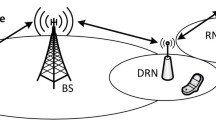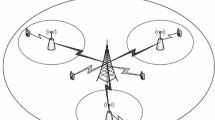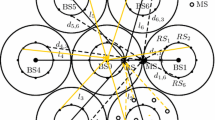Abstract
A robust optimization framework for cross layer optimization is proposed to deal with time varying channels, reducing the required channel state feedback overhead and giving strong QoS guarantees. Lower bounds for the achieved goodput when robust scheduling is used are derived and through simulation we study the impact in terms of blocked calls and QoS achieved by the robust solution for two different cell topology layouts: when 2-hop relaying is allowed and when only direct base station to user transmissions are allowed. The results reveal that the price of robustness is lower for the 2-hop case than the single hop case.








Similar content being viewed by others
Notes
When using link adaptation or power control this may be decided at the access node; in which case stronger QoS guarantees may be given, but maintaining an high overhead between transmitter and receiver.
Abbreviations
- N :
-
Set of all nodes (base stations, relays and users), with elements \(n = 1, \ldots, |N|\);
- L :
-
Set of all links (transmitter and receiver node pairs), with elements \(l = 1, \ldots, |L|\);
- R :
-
Set of available modulation and coding schemes, with elements \(r = 1, \ldots, |R|\);
- U :
-
Set all users, with elements \(u = 1, \ldots, |U|\);
- \(\Uplambda\) :
-
Set of transmission groups, with elements \(i = 1, \ldots, |\Uplambda|\);
- L(n):
-
Set of links adjacent to node n;
- \(\mathcal{P}\) :
-
Set of paths between a base station and a user, with elements \(p = 1, \ldots, |\mathcal{P}|\);
- \(\mathcal{P}(l)\) :
-
Set of paths traversing link l.
- p l :
-
Transmit Power allocated to link l;
- r pu :
-
Rate through path p for user u;
- \(\uptheta_{lr}\) :
-
Binary variable indicating if link l is active and transmitting using modulation and coding scheme r;
- \(\uplambda_i\) :
-
Airtime/resources proportion devoted to transmission group i;
- c li :
-
Instantaneous rate for link l in transmission group i;
- s u :
-
Slack between allocated data rate and the user u demand;
- π l :
-
Dual value associated with the capacity constraint for link l;
- π j l :
-
Dual value associated with the capacity constraint for link l after iteration j in the column generation algorithm;
- q :
-
Dual value associated with the airtime constraint;
- q j :
-
Dual value associated with the airtime constraint after iteration j in the column generation algorithm;
- \(\upomega_u^j\) :
-
Dual value associated with the demand constraint of user u after iteration j in the column generation algorithm.
- W :
-
Noise power level at the receiver;
- G kl :
-
Instantaneous power attenuation (random variable) between the transmitter of link k and the receiver of link l;
- \(\bar{G}_{kl}\) :
-
Average power attenuation between the transmitter of link k and the receiver of link l;
- c r :
-
Data rate when using modulation and coding scheme r;
- \(\upgamma_r\) :
-
Signal to noise plus interference ratio threshold for modulation and coding scheme r;
- d u :
-
Data rate demand for user u;
- \(\updelta_{kl}\) :
-
Random variable with mean describing the instantaneous power attenuation between the transmitter of link k and the receiver of link l;
- t c :
-
Channel coherence time, i.e. the time between two channel states;
- t s :
-
Schedule validity period, i.e. the time between system state changes;
- t :
-
Elapsed time between two consecutive resource allocations.
References
Bae, C., & Cho, D. H. (2006). Adaptive resource allocation based on channel information in multihop ofdm systems. In VTC-2006 fall (pp. 1–5).
Bertsimas, D., & Sim, M. (2004). The price of robustness. Operations Research, 52(1), 35–53.
Björklund, P., Värbrand, P., & Yuan, D. (2004). A column generation method for spatial tdma scheduling in ad hoc networks. Ad Hoc Networks, 2(4), 405–418.
Cho, J., & Haas, Z. (2004). On the throughput enhancement of the downstream channel in cellular radio networks through multihop relaying. IEEE Journal on Selected Areas in Communications, 22(7), 1206–1219.
ElBatt, T., & Ephremides, A. (2002). Joint scheduling and power control for wireless ad-hoc networks. In INFOCOM (pp. 74–85). New York, NY, USA.
3rd Generation Partnership Project (3GPP). (2010). LTE, evolved universal terrestrial radio access (E-UTRA). Radio frequency (RF) system scenarios (3GPP TR 36.942 version 9.0.1 Release 9).
Ghoniem, A., & Sherali, H. (2009). Complementary column generation and bounding approaches for set partitioning formulations. Optimization Letters, 3, 123–136.
Holma, H., & Toskala, A. (Eds.). (2009). LTE for UMTS—OFDMA and SC-FDMA based radio access. New York: Wiley.
Johansson, M., & Xiao, L. (2006). Cross-layer optimization of wireless networks using nonlinear column generation. IEEE Transactions on Wireless Communications, 5(2), 435–445. doi:10.1109/TWC.2006.1611067.
Kandukuri, S., & Boyd, S. (2002). Optimal power control in interference-limited fading wireless channels with outage-probability specifications. IEEE Transactions on Wireless Communications, 1(1), 46–55.
Kaneko, M., Popovski, P., & Hayashi, K. (2009). Throughput-guaranteed resource-allocation algorithms for relay-aided cellular ofdma system. IEEE Transactions on Vehicular Technology, 58(4), 1951–1964.
Le, L., & Hossain, E. (2007). Multihop cellular networks: Potential gains, research challenges, and a resource allocation framework. IEEE Communications Magazine, 45(9), 66–73.
Lee, J., Park, S., Wang, H., & Hong, D. (2007). Qos-guaranteed transmission scheme selection for ofdma multi-hop cellular networks. In ICC ’07 (pp. 4587–4591).
Lee, K. H., Han, K. Y., Song, J. Y., & Cho, D. H. (2005). Capacity enhancement of uplink channel through spatial reusing in multihop networks. In VTC-2005 fall (Vol. 4, pp. 2770–2774).
Li, Y., & Ephremides, A. (2007). A joint scheduling, power control, and routing algorithm for ad hoc wireless networks. Ad Hoc Networks, 5(7), 959–973.
Oyman, O. (2006). Ofdm2a: A centralized resource allocation policy for cellular multi-hop networks. In ACSSC 2006.
Papadaki, K., & Friderikos, V. (2008). Robust scheduling in spatial reuse tdma wireless networks. IEEE Transactions on Wireless Communications, 7(12), 4767–4771. doi:10.1109/T-WC.2008.070505.
Quek, T., Shin, H., & Win, M. (2007). Robust wireless relay networks: Slow power allocation with guaranteed qos. IEEE Journal on Selected Topics in Signal Processing, 1(4), 700–713.
Tan, C. W., Palomar, D. P., & Chiang, M. (2009). Energy-robustness tradeoff in cellular network power control. IEEE/ACM Transactions on Networking, 17, 912–925.
Yi, Y., Proutière, A., & Chiang, M. (2008). Complexity in wireless scheduling: Impact and tradeoffs. In MobiHoc (pp. 33–42). ACM: New York, NY, USA. doi:10.1145/1374618.1374624.
Acknowledgments
The work reported in this paper has formed part of the Green Radio Core 5 Research Programme of the Virtual Centre of Excellence in Mobile & Personal Communications, Mobile VCE, http://www.mobilevce.com. This research has been funded by EPSRC and by the Industrial Companies who are Members of Mobile VCE.
Author information
Authors and Affiliations
Corresponding author
Rights and permissions
About this article
Cite this article
Quintas, D., Friderikos, V. Robust cross layer optimization in relay aided cellular networks. Wireless Netw 19, 1361–1373 (2013). https://doi.org/10.1007/s11276-012-0538-9
Published:
Issue Date:
DOI: https://doi.org/10.1007/s11276-012-0538-9




